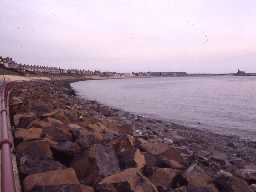Local History
Newbiggin-by-the-Sea (Northumberland)
Newbiggin-by-the-Sea is a coastal parish in south-east Northumberland. It has a wide variety of archaeological features that take the history of the area back from the 20th century to the earliest times.
Large numbers of Mesolithic flint tools and waste flakes have been found along the coast north of Newbiggin, at Sandy Lane and at Newbiggin Point. These were probably temporary sites used for hunting or fishing. The numbers of microliths and knapping waste are huge by comparison to other Mesolithic sites in the county and may reflect the amount of collecting being carried out here by many individuals over a long period of time.
In contrast little is known about the Neolithic period. Some of the flints from Sandy Lane are from this time but little is known about the coastal plain of mid and south Northumberland at this time. Although it is likely that there was some tree clearance around the mouth of the River Wansbeck to the south, it does not seem to have been a favoured centre.
Three spearheads found on Newbiggin Moor and a burial cist from Spital Quarry show that Bronze Age people had probably settled here. However, any settlements may have been quarried away. A more enigmatic monument is a standing stone that might also be of this period.
A single find is the only hint of an Iron Age presence in Newbiggin - an iron stirrup from Newbiggin Moor. Other remains may have been quarried away in more recent times or built over by later settlements.
Much more is known about medieval Newbiggin. The Church of St Bartholomew ' recognisable for miles along the coastline with its medieval spire, stands on a headland away from the village and may have origins in early medieval times. At this time, Newbiggin had its own market charter and was thriving, acting as a major port between Newcastle and Berwick. Historic documents record that there was a pier here and remains of a hospital and coffins were discovered in the 1920s. The place-names Spital Carrs and Spital Point recall the general area of these finds. Traces of the layout of the medieval town can be seen in outlines of burgage plots that run off from Front Street.
Most of the post-medieval history of Newbiggin has been dominated by coalmining in the general area. However, the attraction of the seaside and the absence of a large port led to the rise of Newbiggin as a greater residential centre. The arrival of the railway in the 19th century and the building of Newbiggin Railway Station helped its growth.
A reminder of more recent events lies in the pillboxes that were built to defend the industrialised coastline from attack. These included two each at Newbiggin Point and Spital Point. Further military activity was a range at the mouth of the River Wansbeck.
Large numbers of Mesolithic flint tools and waste flakes have been found along the coast north of Newbiggin, at Sandy Lane and at Newbiggin Point. These were probably temporary sites used for hunting or fishing. The numbers of microliths and knapping waste are huge by comparison to other Mesolithic sites in the county and may reflect the amount of collecting being carried out here by many individuals over a long period of time.
In contrast little is known about the Neolithic period. Some of the flints from Sandy Lane are from this time but little is known about the coastal plain of mid and south Northumberland at this time. Although it is likely that there was some tree clearance around the mouth of the River Wansbeck to the south, it does not seem to have been a favoured centre.
Three spearheads found on Newbiggin Moor and a burial cist from Spital Quarry show that Bronze Age people had probably settled here. However, any settlements may have been quarried away. A more enigmatic monument is a standing stone that might also be of this period.
A single find is the only hint of an Iron Age presence in Newbiggin - an iron stirrup from Newbiggin Moor. Other remains may have been quarried away in more recent times or built over by later settlements.
Much more is known about medieval Newbiggin. The Church of St Bartholomew ' recognisable for miles along the coastline with its medieval spire, stands on a headland away from the village and may have origins in early medieval times. At this time, Newbiggin had its own market charter and was thriving, acting as a major port between Newcastle and Berwick. Historic documents record that there was a pier here and remains of a hospital and coffins were discovered in the 1920s. The place-names Spital Carrs and Spital Point recall the general area of these finds. Traces of the layout of the medieval town can be seen in outlines of burgage plots that run off from Front Street.
Most of the post-medieval history of Newbiggin has been dominated by coalmining in the general area. However, the attraction of the seaside and the absence of a large port led to the rise of Newbiggin as a greater residential centre. The arrival of the railway in the 19th century and the building of Newbiggin Railway Station helped its growth.
A reminder of more recent events lies in the pillboxes that were built to defend the industrialised coastline from attack. These included two each at Newbiggin Point and Spital Point. Further military activity was a range at the mouth of the River Wansbeck.
N13828
UNCERTAIN
Disclaimer -
Please note that this information has been compiled from a number of different sources. Durham County Council and Northumberland County Council can accept no responsibility for any inaccuracy contained therein. If you wish to use/copy any of the images, please ensure that you read the Copyright information provided.

